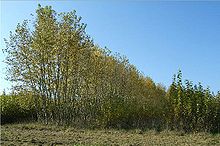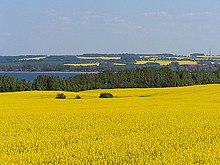Energy farmer
An energy farmer is a farmer , in addition to or instead of the traditional activities, such as production of food and feed and / or finishing , in the energy industry operates.
The field of activity of the energy industry is also known as agricultural energy . This includes renewable energies such as bioenergies in particular . This includes the provision of raw materials, such as B. rapeseed for the production of vegetable oil or grain, potatoes and sugar beet for bioethanol or biomass ( substrates ) for biogas .
The conversion of raw materials ( renewable raw materials (Nawaros)) can take place in the energy industry's plants, such as B. a biogas plant happen.
In some cases, the operation of photovoltaic and wind power plants is also counted as part of the field of activity of an energy producer, since agricultural buildings or agricultural areas can be very suitable locations.
The importance of agricultural energies has increased significantly in recent years, so that more and more training and further education opportunities for energy management are offered.
Provided energies
- (see article agricultural energy and bioenergy)

Energy producers provide energy in the form of biofuels , electricity or heat or they supply the raw materials for their generation. The following energies or energy sources are important:
-
Biogenic fuels
-
Biogenic liquid fuels (especially biofuels):
- Vegetable oil
- Biodiesel
- Bioethanol
- Biomass to Liquid (BtL)
-
biogenic solid fuels to provide heat and z. T. also electricity:
- straw
- Wood from the company's own forest or from hedge trimmings
- Wood from short rotation plantations on agricultural land
- Biomass of other fast growing plants such as B. Miscanthus
-
Biogenic fuel gases for the provision of electricity and often also heat or as fuel:
- Biogas (raw biogas)
- Biomethane
-
Biogenic liquid fuels (especially biofuels):
- Electricity from other renewable energies:
- Electricity from solar energy (photovoltaics)
- Electricity from wind (wind turbines)
History and perspective

For a long time, the energy supply through agriculture was not of great importance. In the 1950s there were efforts to produce biogas from agricultural waste or residues such as liquid manure and manure . The low price ( oil price ) and good availability made oil unrivaled for decades. With the oil crisis in the 1970s, there were renewed efforts in research and industry to develop alternative energy sources. Due to the relatively low oil price in the 1990s, these were again not economically interesting. In the 1990s, factors such as limited resources, independence from oil and gas exporters, environmental protection and, increasingly, climate protection became more important, so that politicians and the economy tried again to activate alternative energy sources. In particular, the record high oil and natural gas prices in 2007/08 made the future profitability of renewable energies appear realistic.
For farmers, the supply of energy has increasingly become an interesting alternative in recent years, as the prices for traditional agricultural products had shown a downward trend over the years until the mid-2000s. In addition, until 2008 there was compulsory set-aside in the European Union (EU) , as a result of which up to 10% of the arable land had to be set aside in a few years to reduce the production surplus. The cultivation of renewable raw materials, e.g. B. also for power generation, but was approved. Another impetus came from the reduction in the maximum permitted sugar exports from the EU in accordance with the European Sugar Market Regulations 2005, which freed up more acreage.
An important factor in Germany was and is the Renewable Energy Sources Act (EEG), which came into force in 2000 and provides a 20-year remuneration guarantee for electricity, e.g. B. from biogas, wind and sun, guaranteed and thus offers investment security. In Germany, biofuels were temporarily exempt from tax in accordance with the Energy Tax Act , which ensured their competitiveness with fossil fuels. The tax exemption will gradually be abolished and replaced by a compulsory admixture of biofuels to conventional fuels. The demand created in this way is also covered by cheaper imports, so that it is unclear what role the production of fuels or the provision of raw materials will play for energy producers in the EU in the future.
According to the market research institute trend: research, more than 80% of all biogas systems and 21% of all solar systems are owned by farmers. They also benefit from the leasing of agricultural land for further plants. The Federal Association of Energy and Water Management (BDEW) therefore estimates that around a third of the EEG surcharge goes to farmers: in 2012 that was six to seven billion euros.
education
With the increasing importance of renewable energies in agriculture, the demand for and supply of further training and training opportunities also increased. Numerous opportunities for the qualification of biogas plant operators and service staff as well as advanced training and courses for farmers in the field of biomass use, energy wood , oil mill operation , solar energy, etc. are offered. Further training to become an energy manager with an IHK certificate is regularly carried out by the Cerchov energy association in the Bavarian energy region of Waldmünchen . In addition, a number of advanced and further training courses are offered, which correspond to different degrees with the necessary skills and knowledge of an energy manager.
Individual evidence
- ↑ a b Christian Gienapp: The farmer as an energy farmer - opportunities and perspectives ( Memento of the original from February 22, 2014 in the Internet Archive ) Info: The archive link was inserted automatically and has not yet been checked. Please check the original and archive link according to the instructions and then remove this notice. (PDF; 226 kB), lecture as part of an event on the subject of bioenergy, the basis for competitive and sustainable agriculture by the specialist agency for renewable raw materials . V. (FNR), March 8 and 9, 2006, accessed January 8, 2010.
- ↑ a b NachwachsendeRohstoffe.de: Nicole Paul: Renewable raw materials: Who trains ?, ( Page no longer available , search in web archives ) Info: The link was automatically marked as defective. Please check the link according to the instructions and then remove this notice. Information from the Agency for Renewable Resources e. V. (FNR), September 29, 2006, accessed January 7, 2010.
- ↑ a b General-Anzeiger.de: Sabine Schrader: New professions in the bioenergy industry - from farmer to energy manager, April 20, 2007, accessed on September 7, 2017.
- ↑ Innovationsreport.de: Bioenergy - “The farmer as an energy manager”, January 12, 2005, accessed on January 8, 2010.
- ↑ B. Eder, H. Schulz: Biogas practice. Basics, planning, plant construction, examples and profitability of biogas plants. 3rd edition, Ökobuch Verlag, Staufen 2006, ISBN 978-3-936896-13-8 .
- ↑ Farmers earn well from the energy transition, NWZ Online, August 7, 2013.
Web links
- Bioenergy basis for competitive and sustainable agriculture, DECHEMA and FNR eventon March 8th and 9th, 2006, summaries of the various presentations available
- Westphalian farmers as energy farmers (article)

